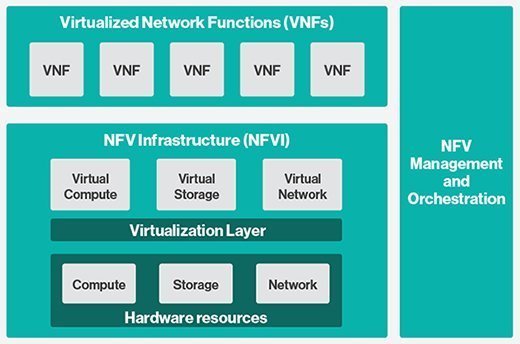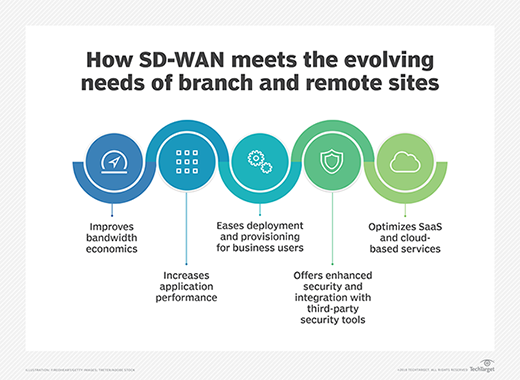
alphaspirit - Fotolia
NFV systems converge virtual network services at the edge
Explore functions, products and use cases that illustrate how NFV and edge computing trends combine SD-WAN endpoints and other network services on single pieces of hardware.
Think back to those pre-smartphone days when we were awash in gadgets -- flip phones, digicams, MP3 players, GPS fitness trackers, Nintendo Game Boys, Palm Treos, etc. There were so many you almost needed a bandoleer whenever you went out. Yet, product categories that were once multibillion-dollar markets collapsed after modern smartphones merged all those functions into a single convenient device. Skip forward a decade and the same thing is happening to the networking industry thanks to, among other developments, network function virtualization, or NFV, systems.
Features once delivered via discrete pieces of hardware have been encapsulated as software applications running as virtual appliances on any server. Server virtualization and containerization are the foundation of today's enterprise software stack. What virtualization did for business applications it is now doing to network services in the form of NFV and virtual or universal customer premises equipment, otherwise known as VCPE and uCPE, respectively.
The arguments for using a server to run multiple network services are similar to those for merging a camera, media player and GPS mapper into a phone: It offers improved flexibility, convenience, performance and manageability at lower cost by exploiting the economies of scale and steep technology curve of commodity silicon. Instead of the smartphone's low-power systems on chip (SoCs), imaging chips and touch displays, NFV systems and infrastructure exploits increasingly powerful server processors, switch silicon and solid-state storage that enable a high-density chassis to accommodate multiple network applications and user sessions.
Software-defined networking (SDN) and functions benefit carriers and enterprises alike. Carriers were first to see the advantages of NFV, having implemented most of the early NFV deployments. However, as enterprises redesigned their networks using software-defined WAN (SD-WAN) to provide cheaper, high-performance connectivity to branch offices, warehouses and temporary worksites, they rediscovered the advantages of distributed infrastructure, aka edge computing. The two trends --network function virtualization and edge computing -- have now crossed paths as edge infrastructure has emerged as the way to combine SD-WAN endpoints and other network services on a single piece of hardware.
A rapidly growing market
Like most nascent and dynamic trends, there aren't firm or widely accepted boundaries for NFV edge hardware. The semantic imprecision leads to varying estimates of the market size and growth rate. Most network watchers agree sales are surging, however.
The market for edge virtual networking is composed of three categories:
- NFV infrastructure (NFVI) -- namely, equipment at an enterprise data center or within a carrier network -- including the core, central offices and, soon, wireless base stations.
- Virtual customer premises equipment comprising the network application and system software.
- Universal customer premises equipment or the hardware, which might be a purpose-built appliance, remote switch/router, or small server. Small, low-power uCPE typically includes appliances using an SoC (Arm, NXP/Power, MIPS) or low-end Intel CPU (Atom, Celeron).

Together, these components provide virtual implementations of network services and are seeing explosive growth (see below).
The virtualization of network functions is on the rise
The following is a summary of recent market estimates for the components that make the virtual implementation of network services possible:
- An IDC vCPE/uCPE forecast pegged the total revenue of network edge hardware and software at about $0.8 billion in 2018, and then growing at about 31% compound annual growth rate to almost $3.2 billion in 2023.
- A separate IDC report on the telecom virtual network functions (VNF) market predicted 45% annual growth to reach more than $16 billion in 2022.
- IHS Markit estimated the uCPE will be a billion-dollar market by 2022.
- Technavio projected the vCPE market will grow at 45% annually to reach about $3.6 billion by 2023.
- While Gartner hasn't publicized revenue estimates, it predicted that by 2023, "65% of global enterprises will employ unified communications solutions that are deployed over SD-WAN, up from less than 10% in 2018." These will primarily be endpoints for telecom services, as "only 10% of enterprises will implement premises-based network function virtualization services."
Admittedly, such high growth rates are typical of an emerging market starting from nothing. However, several factors will cause sales of NFVI, vCPE and uCPE to reach multibillion-dollar proportions. These include the following:
- Telecommunications carriers building distributed software-defined networks using edge infrastructure to deliver 5G capacity (via virtual radio access network technology), network services and streaming content.
- Enterprises embracing SD-WAN to replace conventional WAN circuits and using converged infrastructure to deliver both network and application services. Indeed, Gartner predicted 65% of enterprises will deploy virtual network services over SD-WAN by 2023, while further estimating that 30% of enterprise locations will rely solely on internet broadband circuits, up from 10% in 2019.
Functionality and use cases
Aside from the cost-effectiveness of using commodity components, the chief benefit of converged virtual network infrastructure is the flexibility to run multiple services on a single piece of hardware. The software-based design can also combine multiple VNFs into so-called service chains, such that an SD-WAN endpoint terminates into a voice over IP (VoIP) session border controller or firewall.
The most popular VNFs for both large enterprises and SMBs include:
- SD-WAN
- Firewall (typically, using next-generation software that adds deep packet inspection, Layer 7 filtering and intrusion prevention systems)
- Routing and switching
- Application delivery controller for Layer 3 to Layer 7 load balancing
- Media server and content delivery/caching
- Session border controller (VoIP management and security over public internet circuits)

NFV systems products
The point of NFV and vCPE is to decouple network hardware from software to provide the flexibility to use any processor architecture and system design capable of running a virtualization or container stack. Such adaptability makes compiling an exhaustive list of NFV products an impossibility, because any computer -- whether a 4U, 4S behemoth with a terabyte of RAM or a Raspberry Pi using an Arm SoC with a gigabyte of memory -- can run virtual network services. Nonetheless, system vendors have responded to increased interest in converged virtual services by releasing products tailored to network edge environments.
The following is representative of currently available products.
- Cisco CSP 5000 series includes 1U and 2U, 2S systems based on the UCS C220 and C240 server with a version of Red Hat Enterprise Linux customized for NFV applications. Cisco CSP 5000 systems support a wide range of Cisco VNFs including:
- Cloud Services Router 1000V and XRv 9000 routers
- Adaptive Security Virtual Appliance (ASAv)
- Firepower Next-Generation Firewall
- Virtual Wide Area Application Services (vWAAS)
- Web Security Virtual Appliance
- Virtual Security Gateway and Virtual Supervisor Module for the Nexus 1000V
- Cisco ENCS 5000 is a hybrid compute-router platform for enterprise edge deployments. ENCS bundles Cisco's virtual Integrated Services Router, integrated SD-WAN software, vWAAS, ASAv and Virtual Wireless LAN Controller, along with support for the vendor's NFV Infrastructure Software platform.
- Cisco HyperFlex Edge hyper-converged infrastructure (HCI) is a line of 1U, 2S servers supporting up to 128 GB and three to eight drives designed for edge applications including NFV.
- ClearFog CX LX2K and CX CN9K COM Express type 7 Network Platforms are small form-factor, SoC-based systems with 100 and 10 Gigabit Ethernet (GbE) interfaces designed for uCPE applications using an embedded Linux kernel.
- Dell Virtual Edge Platform (VEP) 4600 is a uCPE product that supports SD-WAN and other VNFs. It is available as an expandable 1U system with 2x10 GbE and 4x1 GbE or small appliance with 2x10 GbE and 6x1 GbE. VEP products support VMware ESXi and Velocloud (SD-WAN), Versa (SD-WAN) and Adva Ensemble network virtualization platform.
- Dell PowerEdge R640, R740xd or VxRail D Series are 1U HCI systems suitable for NFV workloads when paired with VMware vCloud NFV, a version of vCloud that includes NSX-T and is optimized network applications.
- HPE Edgeline Converged Edge Systems is a line of 1U, 2U and blade servers designed for both remote offices and harsh environments (via ruggedized hardware). Similar to the Dell products, Edgeline doesn't include an NFV stack but supports the same VMware software or other Linux/OpenStack networking platforms.
- Lanner vCPE/uCPE platforms are x86-based appliances in both rackmount or desktop configurations, with up to 16 10 GbE ports and optional Wi-Fi and LTE connectivity validated with many VNF products.
- Lenovo ThinkSystem Edge servers (SR655, SR650, SR630 and SE350) are verified as Intel Select Solutions for NFVI with models optimized for network workloads in the remote office, mobile edge and carrier core.
Why interest in edge NFVI now?
Four factors underlie enterprise interest in edge servers with NFVI:
- Increasing preference for SD-WAN over broadband, instead of traditional data circuits for remote connectivity.
- The broad availability of virtual software appliances for SD-WAN and other networking services.
- The processing power available from compact, small form-factor and 1U systems that can run VM or container stacks hosting multiple applications.
- Infrastructure management software capable of centralizing the administration, monitoring and governance of distributed systems under a single interface.
Together, these factors provide enterprises with the flexibility to consolidate network services and enterprise applications on the same NFV systems and hardware. Doing so improves the performance, efficiency and scalability of remote infrastructure -- and at lower cost -- than traditional purpose-built network hardware.






